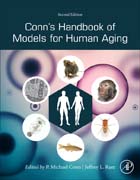
Handbook of Models for Human Aging, Second Edition has been fully updated while keeping the spirit of the first edition by presenting each animal and presenting key aspects of biology, nutrition, factors affecting life span, methods of age determination, use in research, and disadvantages/advantages of use. Using a multidisciplinary approach, it is designed as the only comprehensive work that covers the diversity of aging models currently available. Chapters on comparative models explore age-related diseases including Alzheimer's, joint disease, cataracts, cancer, and obesity. Also included are new tricks and approaches not available in primary publications. This must-have handbook is an indispensable resource for researchers interested in the mechanisms of aging, gerontologists, health professionals, and allied health professionals and students. Combines both the methods of study for human aging and animal modelsProvides a historical overview and discussion of model availability, key methods, and ethical issuesContains over 200 full color illustrations INDICE: Introduction 1. Historical Development of Animal Models of Aging 2. Species Selection in Comparative Studies of Aging and Anti-Aging 3. Principles of Animal Use for Gerontological Research 4. From Primary Cultures to the Aging Organism: Lessons from Human T Lymphocytes 5. Models of Systems Failure in Aging 6. Major Issues in Ethics of Aging Research 7. Ethical Aspects of Research Involving Elderly Persons General Methods 8. SAGE KE and Other Online Resources Related to Aging' 9. Proteomics in Aging Research 10. Application of High-throughput Technologies to Aging-related Research 11. Models of Alzheimer's Disease 12. Age-Related Hippocampal Dysfunction: Early Alzheimer's Disease vs Normal Aging 13. Epidemiology in Aging Research 14. Statistical Issues for Longevity Studies in Animal Models 15. Models for the Study of Infection in Populations 16. Estimation of the rate of production of oxygen radicals at mitochondria Animal Models A. Premammalian Systems 17. Telomeres and Aging in the Yeast Model System 18. Longevity and Aging in the Budding Yeast 19. From Yeast Methuselah Genes to Evolutionary Medicine 20. Strongyloides Ratti: A Nematode with Extraordinary Plasticity in Aging 21. Insect Models for the Study of Aging 22. Drosophila Models of Aging 23. Models of Aging in Honeybee Workers 24. Ants as Naturally Long-lived Insect Models for Aging B. Mammalian Systems 25. Gene Expression and the Extended Longevity Phenotypes of Drosophila melanogaster 26. Annual Fish as a Genetic Model for Aging 27. The Use of Mature Zebrafish (Danio rerio) as a Model for Human Aging and Disease 28. Zebrafish as Aging Models 29. Telomeres In Aging: Birds 30. Domestic and Wild Bird Models for the Study of Aging 31. A Transgenic Mini Rat Strain as a Tool for Studying Aging and Calorie Restriction 32. Rat Models of Age-related Cognitive Decline 33. Aged Rodents for Biogerontology Research 34. Life Extension in the Dwarf Mouse 35. The Canine Model of Human Brain Aging: Cognition, Behavior, and Neuropathology 36. Bats as a Novel Model for Aging Research 37. Memory in the Aging Hippocampus: What can place cells tell us? 38. The Rhesus Macaque as a Model of Human Aging and Age-Related Disease 39. Non-human Primates as a Model for Reproductinve Aging and Human Infertility IV. Comparative Models 40. Neurobiology of the Aging Brain 41. Mitochondrial DNA and Aging 42. Models for Apoptosis 43. Age-related Changes in Hormones and Their Receptors in Animal Models of Female Reproductive Senescence 44. Models of Chaperones in Aging 45. Therapeutic Potential of Stem Cells In Aging Related Diseases 46. Nuclear Transfer and Cloning: Preservaton or Expansion of Proliferative Lifespan? 47. Human Models of Longevity 48. Computational Models of Mitochondrial DNA in Aging 49. Mouse Models of Accelerated Aging V. Disease-States and Normal Aging A. Disease States 50. Models, Definitions, and Criteria of Frailty 51. Fertility and Aging Men 52. Benign Prostatic Hyperplasia 53. Murine Models of Infectious Diseases in the Aged 54. Physiopathology, clinical symptoms and causative agents of pneumonia 55. Diabetes and Aging 56. Diabetes as a Model of Premature Aging 57. Frailty as a Model of Agin 58. Osteoporosis and Cardiovascular Disease in the Elderly 59. Depression in Older Patients 60. The Aging Human Lung: Age-associated Changes in Structure and Function 61. Iceland as a Model for Human Aging 62. Behavior and Personality in the Study of Successful Aging B. Health Issues Affecting the Elderly 63. Andropause 64. Aging and the perceptual organization of sounds: a change of scene? 65. Models of Immune Function in Aging 66. Human T Cell Clones in Long-term Culture as Models for the Impact of Chronic Antigenic Stress in Aging 67. Age-Related Changes in the Human Retina 68. Models of Age Related Vision Problems 69. Health, Functional and Therapeutic Implications of Obesity in Aging 70. Age and Joints 71. Sleep Quality in the Elderly 72. Atherogenesis and Aging 73. Managing Menopausal Symptons 74. Psychological Aging: A Contextual View 75. Nutrients and Aging C. Approaches to Treatment and Models 76. Methods for Studying Hearing Impairment and Auditory Problems of the Aged 77. A Model for Understanding the Pathomechanics of Osteoarthritis in Aging 78. Aging and Cardiovascular Angiogenesis Models 79. Models for the Study of Stroke 80. Werner Syndrome as a Model of Human Aging 81. Models of Sarcopenia 82. Aging of Human Skin 83. Models of Hypertension in Aging
- ISBN: 978-0-12-811353-0
- Editorial: Academic Press
- Encuadernacion: Cartoné
- Páginas: 1184
- Fecha Publicación: 01/05/2018
- Nº Volúmenes: 1
- Idioma: Inglés
